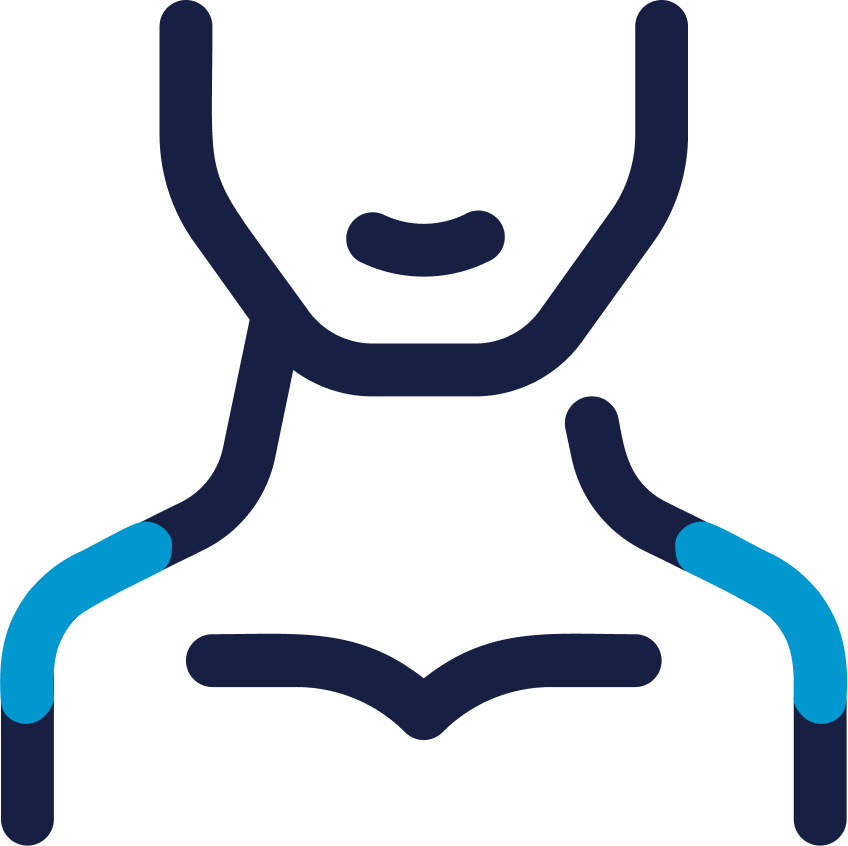
- Common Conditions
- /Shoulder

The shoulder is the most flexible joint in the body. It allows you to lift your arm, rotate it, and reach above your head and behind your body. However, with this exceptional range of motion also comes the potential for instability and damage.
When subluxation occurs, the humeral head (the ball) of the shoulder slips out of the glenoid cavity (the socket), and then goes back into place without manual reduction. A complete dislocation is when the ball comes out of the socket, and remains dislocated. It sometimes will reduce (go back in place) on its own, but will stay out of place and require reduction by a professional. As a chronic condition, shoulder instability causes frequent subluxations/dislocations of the shoulder joint.
There are three types of instability:
The symptoms of subluxation and/or dislocation vary from person to person, and can include one or more of the following:
There are several causes of shoulder subluxation and/or dislocation. The most common causes include:
Anyone is at risk of developing shoulder subluxation and/or dislocation; however, the risk for developing this condition is greater in people who excessively use this joint, including:
An orthopaedic surgeon’s initial diagnosis includes performing a physical examination of the shoulder and taking a history of the patient’s past experiences and pain. This initial assessment will allow a doctor to pinpoint the cause of the pain.
After the initial physical evaluation and assessment, further diagnostic techniques will be used to accurately diagnose subluxation and/or dislocation. Additional diagnostic techniques include:
Surgical and non-surgical methods can be used to treat shoulder subluxation and/or dislocation.
Non-surgical methods treatment options include:
Surgical treatment options are considered when the symptoms of subluxation and/or dislocation interfere with everyday life, including:
Arthroscopy is the least invasive form of surgery for shoulder subluxation/dislocation and/or instability. The benefits of this type of surgery over an open surgical procedure include:
Recovery from shoulder subluxation and/or dislocation varies by individual and extent of the condition. It begins with initial improvement in flexibility and strength and ultimate leads to the return to work, sports, and other activities.
In the case of mild shoulder instability, recovery generally takes between one and four weeks. Post surgical recovery will take 4-6 months. It is important to note that a return to contact sports may not be permitted until six months after the surgery.
During recovery, physical therapy and strength training exercises are keys to improving the use of the shoulder. It is vital to follow the recommendations made by your physician during the recovery phase.
While some chiropractors do treat shoulder instability or dislocation, you'll want to see your orthopaedic surgeon, such as Dr. O'Grady and his staff.
With shoulder dislocations, your first step would be the emergency department where trained emergency specialists can help reduce the dislocation and manage joint swelling and pain. O’Grady Orthopaedics would be your next stop for follow-up expert care. Dr. O'Grady will help decide if you need surgery or other types of treatment, including follow-up care like physical therapy.
The joint will sometimes reduce (go back into place) on its own, however this can be dangerous. The best course of action after a dislocation is to stabilize the affected joint in its current position and seek immediate medical attention.
Your shoulder is a very flexible joint, perhaps the most flexible out of all other joints in your body. Your shoulder allows you to reach behind your body or over your head, as well as lift and rotate your arm. These different ranges of motion, however, come with the potential for damage and instability.
A dislocation occurs when the humeral head (ball of the shoulder joint) slips out of the glenoid (socket) and remains displaced. A subluxation occurs when the humeral head slips out of the glenoid, but reduces by itself (goes back into place). Shoulder instability, as a chronic condition, causes regular dislocations or subluxations of your shoulder joint.
Symptoms of shoulder instability or dislocation can result in pain in your shoulder, “popping out” or “giving out” of your should, and a feeling that the shoulder is hanging or loose.
Yes, shoulder dislocation can lead to a rotator cuff tear. If this happens, you may experience symptoms of pain down the outside or in front of your shoulder, stiffness, and weakness.
Your orthopaedic surgeon will perform a physical exam of your shoulder and discuss your medical history, including any past pain or experiences. They may take specific tests to help them assess your shoulder instability as well as test your ligaments for general looseness.
Dr. O'Grady may order imaging tests, such as an x-ray or MRI, to help with the diagnosis and see if they're any additional issues. These diagnostic techniques will help him diagnose either dislocation or subluxation accurately so he can put you on a treatment plan as soon as possible.

